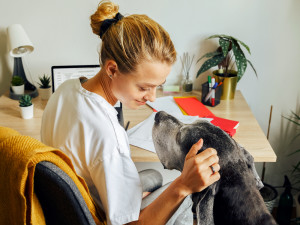What’s Better Than a Tail Wag? A Circle Wag
Also called the “propeller wag” or “helicopter tail”, this behavior is a surefire way to tell that a dog is happy.

Share Article
The way your dog wags their tail says a lot about how they’re feeling. That’s because there is a lot of information contained in the movement — tail wags can mean so many things. The speed, amplitude, and looseness of the tail are all informative when assessing a tail wag, as is the height of the tail. The complexity of the tail wag is immense, and while many people unfamiliar with dog behavior think that a tail wag means a dog is friendly and happy, dog savvy people all know that this is an inaccurate and oversimplified interpretation.
However, there is one particular type of tail wag that means what most people think a tail wag means — that the dog is happy or friendly (or both). That type of wag is called a “circle wag,” “propeller wag,” or even a “helicopter tail.” All terms mean that the tail is rotating at the base and that the tip is moving in a broad circle. I love to see circle wags because they tend to indicate such friendly, happy dogs.
What Does a “Circle Wag” Mean?
Most often, a dog will wag their tail in a circle if they are particularly overjoyed to see someone special, especially someone they haven’t seen recently. Many videos of reunions between military people returning from deployment and the dogs that stayed behind feature circle wags. Some dogs have this level of enthusiasm — and the corresponding circle wag — every time they greet members of their family, no matter the length of the absence.
Generally, the more the wag encompasses the whole body, the friendlier the dog’s intentions. The full body tail wag that extends from the shoulders through the belly to the hips and the tail is the classic friendly tail wag. Even though a circle wag is typically interpreted (and accurately so) as a sign of friendliness and positive emotions, I’ve often wondered if even that isn’t an oversimplification.

Is That Always the Case?
Years ago, I had a dog named Bugsy, who loved to play with most other dogs and generally had good social skills when off leash with them. However, I had to work very hard to manage him around toys or food because his natural inclination was to be possessive of anything he considered valuable, and to act aggressively towards a dog or a person around his so-called treasures. Additionally, he would bark, growl, and lunge whenever he saw a dog while he was on a leash. To add to his list of issues, he showed signs of fearfulness in a lot of different situations.
Bugsy would move his tail in a circle wag when charging at other dogs who came onto our property. He would bark and stiffen — not signs of friendliness by any stretch of the imagination — but when he reached the dog, he would initiate play after a tense greeting. It is one of the few times I have seen a dog exhibit a circle wag when not in an obviously friendly or happy mode, but he really did like playing with dogs, so maybe he was anticipating that? My guess is that he was in an ambivalent state — open to the possibility of a friendly encounter, but nervous about the other dog at the same time.
Some dogs wag their tails in circles regularly, perhaps in response to any positive experience. Other dogs only do it at specific times, such as when greeting their best dog buddy, when their guardian comes home after being away all day, or when they realize that it is time for a walk.

Karen B. London, PhD, CAAB, CPDT-KA
Karen B. London is a certified applied animal behaviorist (CAAB) and certified professional dog trainer (CPDT) who specializes in working with dogs with serious behavioral issues, including aggression. She has written for a variety of magazines including The Bark, Clean Run, and the APDT Chronicle of the Dog, and has published in scientific journals including Behavioral Ecology and Sociobiology, Ethology, Ecology, and Evolution, the Journal of Insect Behavior, and Insectes Sociaux. She is the author of seven books about dog training and canine behavior, including the forthcoming My Dog's Mystery Adventure: And Other Stories From a Canine Behaviorist and Dog Trainer.
Related articles
![Dog in the sand smiling at the camera]()
Can Dogs Smile?
There’s a big difference between a dog smiling and showing their teeth.
How to Manage Leash Reactivity in Your Dog
If your pup acts diabolical on walks, you are not alone. Here’s what you can do.
Does Your Dog Have Happy Tail Syndrome?
If your pup's exuberant tail wagging has led to injury, they could have this condition.
![Young woman sitting at desk petting her senior Great Dane]()
How to Speak “Dog”
Lili Chin’s book Doggie Language illustrates how dogs communicate — beyond ear perks and tail wags.





